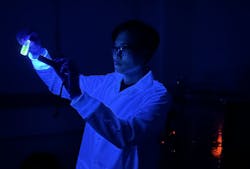A new class of hybrid perovskites brings tunability and stability
A team of Purdue University (West Lafayette, IN) and Duke University (Durham, NC) researchers is growing hybrid perovskites by controlling the arrangement of multiple organic and inorganic layers within their crystals, which allows them to control the energy levels of electrons and positive charge carriers (a.k.a. holes).
It’s a big deal because this tuning affects the perovskites’ optoelectronic properties and ability to emit light of specific wavelengths—and to function as a source for lasers (see video).
“Perovskites are a relatively new family of materials with a lot of potential for optoelectronic applications,” says Letian Dou, an associate professor of chemical engineering at Purdue. “Being able to control the number of layers/thickness seemed like a crucial step for the field. Three-dimensional (3D) perovskites with an infinite number of layers are chemically unstable, and it’s difficult to tune emission color. Controlling the ‘layers’ makes perovskites much more stable, and we can also tune the color via ‘quantum confinement.’”
Dou’s group worked with Volker Blum, an associate professor of mechanical engineering and materials science at Duke, whose theoretical group performed computational simulations to predict the electronic structure and properties of the materials. This side of the work involved simulating structures up to 900 atoms with advanced methodology—and required throwing some of the most powerful supercomputers on the planet at it to be able to handle the calculations.
Halide perovskites are very promising lasing materials, thanks largely to their high optical gain and emission efficiency. While two-dimensional (2D) perovskites are more stable, the single-layer (n=1) 2D perovskite is too soft and the ‘electron and phonon’ are coupled too strongly to allow lasing to happen.
“Expanding the number of layers and using our specially designed organic semiconductor molecules allows us to alter the chemical rigidity of the materials and lower the lasing threshold, which led to efficient lasing properties,” says Jee Jung Park, a graduate student working with Dou at Purdue (see figure).
Surprising results
The team achieved efficient lasing from double-layered perovskites, aided by their special organic molecules, and were extremely surprised because it wasn’t an expected outcome.
“We came to really embrace and see the real potential of perovskite design for laser applications,” says Dou. “The moment we saw the crystals came out was very exciting.”
Another surprise was obtaining such complex hybrid single crystals. Previously, researchers had a difficult time growing high-quality single crystals—even for n=1 single-layer OSIP materials, which have much simpler structures.
One of the biggest challenges involved was the synthesis of the single crystals for in-depth analysis. “The moment we created large, high-quality single crystals was a turning point for our research,” says Park. “Choosing the right solvents and the right method carefully was critical.”
As far as applications, with more control of tunability and efficiency, perovskites can be used as highly efficient emitters such as light-emitting diodes and laser devices in the future.
The team plans to continue to design new structures and grow even better crystals. “In our most recent work, we didn’t design a cavity for the lasing demonstration,” says Dou. “The optical loss in our randomly shaped crystals is high, so next we’ll work to control the nanostructure morphology and design a better cavity—such as introducing a grating, distributed Bragg reflector, or plasmonic substrates—to greatly enhance lasing performance.”
FURTHER READING
J. Y. Park et al., Nat. Chem. (2023); https://doi.org/10.1038/s41557-023-01311-0.
About the Author
Sally Cole Johnson
Editor in Chief
Sally Cole Johnson, Laser Focus World’s editor in chief, is a science and technology journalist who specializes in physics and semiconductors.

